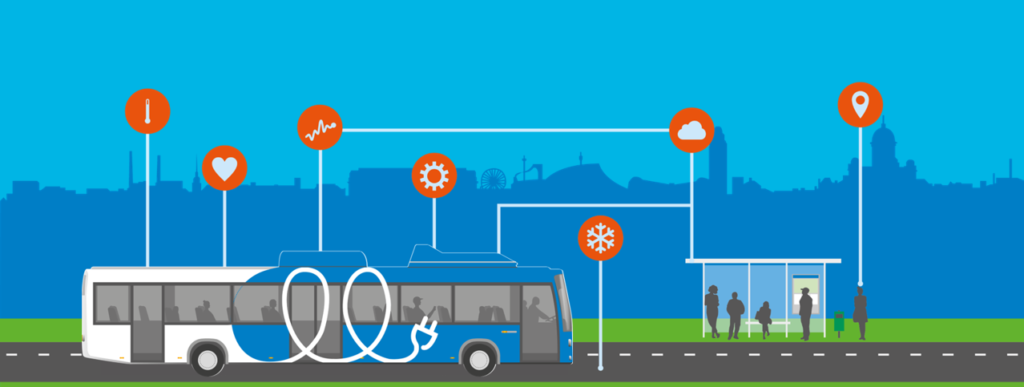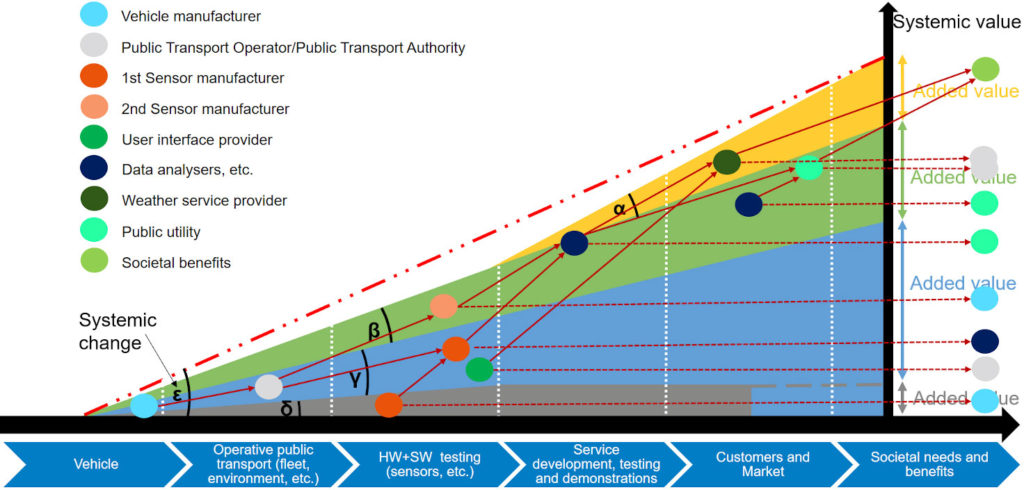A recent study, done as part of VTT’s Living Lab Bus -project, discusses the use of open innovation platforms to create more value in collaboration with multiple stakeholders using shared assets. The main purpose was to describe how different functions of innovation platform create added value in the context of Intelligent Transport Systems.

Figure 1. Living Lab Bus concept (Source: livinglabbus.fi with permission of Living Lab Bus -project).
Innovation platforms
Open innovation platforms are methods that are open for different stakeholders to participate and co-create new solutions. Living Labs are one form of innovation platforms. Living Labs allow businesses to enhance research, development and innovation activities with faster innovation cycles to produce better-optimized and personalized products and services to end-users and other businesses. The most important aspect of Living Labs is the product and service testing in real-life operating environment. In the Living Lab Bus (LLB) -project, VTT and project partners transformed some busses of Helsinki Regional Transport Authority to Living Labs. The general concept idea is presented in Figure 1.
The goal of the innovation platforms is to maximize mutual value of all stakeholders resulting in societal benefits that can be realized with better services for citizens. However, it might be difficult to realize how these innovation platforms create added value for different stakeholders and how the most value can be achieved. Thus, VTT has developed value description called ‘The Value Ramp: Total value of the systemic change in ITS’ to demonstrate the added value of innovation platforms by using data from the LLB -project.
The Value Ramp
The idea behind the Value Ramp is based on previous value creation theories. The study shows how different components of innovation platforms are functions that create added value. Each function has specific purpose in product and service development activities. In the LLB -project those functions were divided in four main categories:
- Lab infra – pre-operational technology development and testing
- Platform for testing hardware in real-life environment
- Developer portal and data
- User interfaces, service delivery and participation
Together these functions create systemic value of the platform. The Value Ramp is depicted in Figure 2. It shows how LLB as an innovation platform creates added value through aforementioned functions and how the systemic value rises by using multiple functions of the platform. The slopes of each function are descriptive and are used to demonstrate how the innovation platform was used during the project. For example in this project, the most valuable function for developers (by the amount of usage) was the ‘Platform for testing hardware in real-life environment’. However, more value can be achieved by utilizing several functions of the platform.

Figure 2. The Value Ramp: Total value of the systemic change in ITS (Source: Lusikka et al. 2020, reproduced under license CC BY 4.0: https://creativecommons.org/licenses/by/4.0/).
The purpose of the Value Ramp is to demonstrate how different stakeholders can create added value with innovation platforms. In addition, it can be used to reason why companies and cities should utilize innovation platforms more frequently in product and service development, and thus justify investments and sustenance of the platforms. Figure 3 represents the Value Ramp in action to describe how different stakeholders collaborate, co-create value and co-capture value by adding functions or using each other’s functions (e.g. data from hardware) to create new and better solutions, services and products for citizens, and thus resulting in societal benefits.

Figure 3. The Value Ramp in action: capturing more value through co-creation (Source: Lusikka et al. 2020, reproduced under license CC BY 4.0: https://creativecommons.org/licenses/by/4.0/).
Further research and opportunities
The value description is planned to be modelled further in new initiatives to describe the amount of captured value more accurately through performance indicators. The LLB -project has ended, but we are working on new initiatives to renew and continue with the enhanced Living Lab Bus environment, and furthermore, creating new environments in other contexts.
Read full article in Utilities Policy (Open Access): Lusikka, T., Kinnunen, T. K., & Kostiainen, J. (2020). Public transport innovation platform boosting Intelligent Transport System value chains. Utilities Policy, 62, [100998]. https://doi.org/10.1016/j.jup.2019.100998
Read more about the Living Lab Bus -project on the project website: livinglabbus.fi.
 Contact:
Contact:
Toni Lusikka
toni.lusikka@vtt.fi
VTT Technical Resarch Centre of Finland, Finland






Follow us: